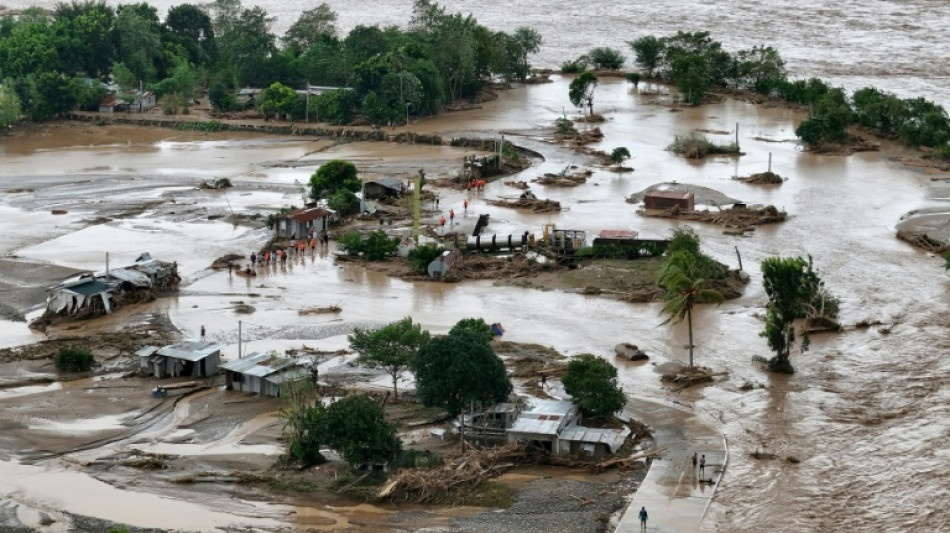

Typhoon Fung-wong floods Philippine towns, leaves 5 dead in its wake
Entire villages lay submerged and scores of towns remained without electricity on Monday as Typhoon Fung-wong left the Philippines after killing at least five people and displacing more than a million.
Fung-wong, with a footprint that spanned nearly the entire archipelago, slammed into the eastern seaboard as a "super typhoon" on Sunday evening, uprooting trees and swamping towns in its path.
It landed days after Typhoon Kalmaegi swept through the islands of the central Philippines, killing at least 224 people.
Cleanup efforts were underway on Monday from Cagayan province in the far north to hard-hit Catanduanes island more than 1,000 kilometres (620 miles) to the south.
In Cagayan, provincial rescue chief Rueli Rapsing told AFP a flash flood in neighbouring Apayao province had caused the Chico River to burst its banks, sending nearby residents scrambling for higher ground.
"We received reports around six in the morning ... that some people were already on their roofs," he said.
Most had been rescued but video verified by AFP showed that some were still trapped.
Mark Lamer, 24, a resident of Cagayan's Tuao town, told AFP it was the "strongest typhoon I have ever experienced".
"We didn't think the water would reach us. It had never risen this high previously," he said.
More than 5,000 people were safely evacuated before the overflowing Cagayan River buried the small city of Tuguegarao about 30 kilometres (20 miles) away.
"Tuguegarao is underwater now," Rapsing said.
A local mayor's office told AFP the Cagayan river was still rising by about 0.3 metres (one foot) every hour.
Scientists warn that storms are becoming more powerful due to human-driven climate change. Warmer oceans allow typhoons to strengthen rapidly and a warmer atmosphere holds more moisture, which means heavier rainfall.
- 'The ground was shaking' -
The storm's death toll rose after five-year-old twins and an elderly man in two northern Luzon provinces were reported killed in landslides.
The children were killed at around 2 am as their family slept inside their home, said civil defence officer Alvin Ayson. Seasonal monsoon rains had saturated the soil around the dwelling before Fung-wong struck, he said.
A mudslide killed the man barely an hour later, local authorities said.
The storm's first fatality came a day earlier further south in Samar province, which was hit hard by Typhoon Kalmaegi a week earlier.
Another death was confirmed on Catanduanes island, where storm surges sent waves hurtling over streets and floodwaters into homes by early Sunday morning.
"The waves started roaring around 7:00 am. When the waves hit the seawall, it felt like the ground was shaking," resident Edson Casarino, 33, told AFP on Sunday.
There was also major flooding in southern Luzon's Bicol region, where verified video showed streets transformed into raging torrents of water.
More than 1.4 million people nationwide were evacuated in the face of the storm.
Schools and government offices across the main island of Luzon were closed on Monday. That included the capital Manila, where residents were cleaning up after a night of heavy rain.
- Next stop, Taiwan -
Fung-wong is now turning towards Taiwan, where it is expected to bring torrential rain to the north and east as it intensifies the seasonal northeast monsoon, Taipei's Central Weather Administration said.
More than 350 millimetres (14 inches) of rain is expected in a 24-hour period across the region, forecaster Stan Chang told AFP.
Nearly 5,000 people will be evacuated from their homes in three townships in the eastern county of Hualien, local government official Lee Kuan-ting said.
The townships are near a barrier lake that burst, killing 19 people, during torrential rain brought by Super Typhoon Ragasa in September.
Typhoon Kalmaegi sent floodwaters rushing through the towns and cities of the central Philippines last week, sweeping away cars, riverside shanties and shipping containers.
Search-and-rescue efforts in hardest-hit Cebu province were suspended at the weekend as Typhoon Fung-wong approached.
President Ferdinand Marcos said on Monday that a "state of national calamity" declared over Kalmaegi would be extended to a full year.
L.Costa--MJ




